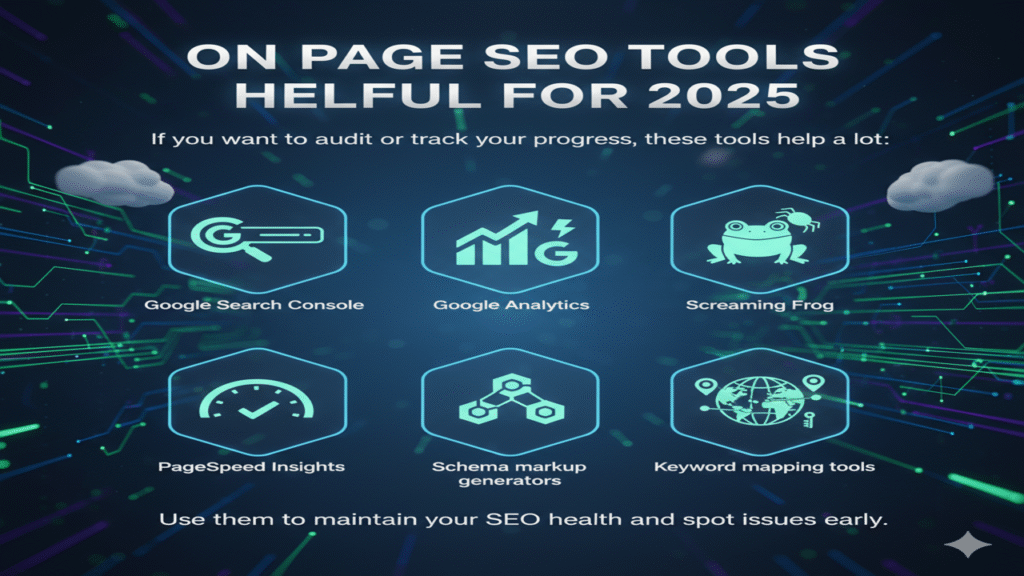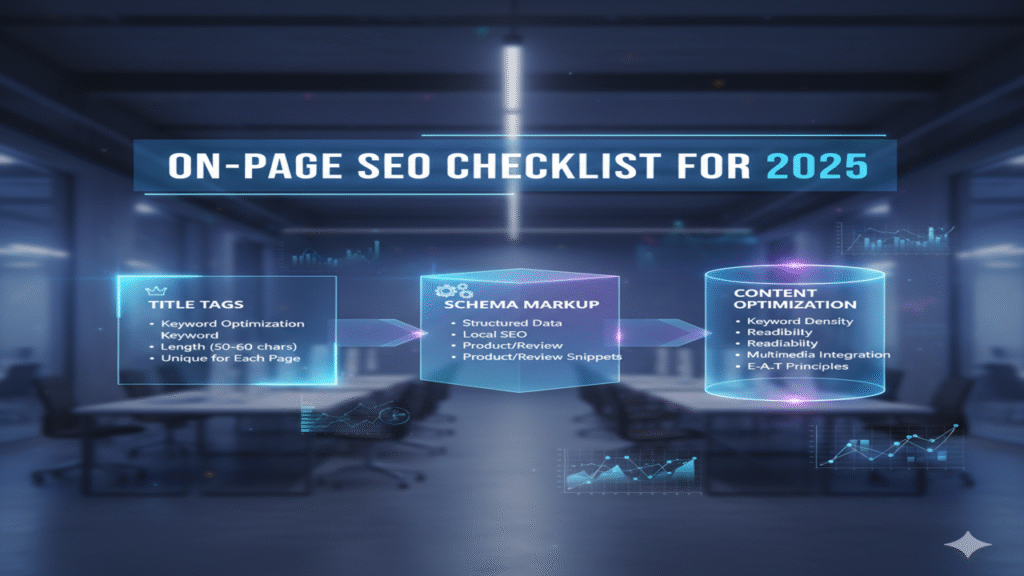If you want your site to show up on the first page of Google in 2025, you can’t rely on outdated tactics anymore. Google’s ranking systems have evolved to understand the intent, analyze page experience, evaluate topical authority, and reward websites that put real effort into user satisfaction. That means your On-Page SEO Checklist must be sharper than ever.
You and I both know how crowded search results are today. But the good news is that strong on page optimization still gives you a huge competitive edge. When your pages are structured well, enriched with schema, armed with strategic title tags, and filled with helpful content, Google sees you as a reliable source. And readers feel the same way.
This On-Page SEO Checklist walks you through everything that matters for on page SEO in 2025 so you can attract more clicks, increase organic visibility, and turn your content into a long term traffic engine.
Table of Contents
Why On Page SEO Still Matters in 2025?
Search engines have gotten smarter, but they still rely on clear signals to determine what your page is about. When your content aligns tightly with searcher intent, uses helpful formatting, and includes structured data, you make Google’s job easier. In return, your site earns better rankings.
On page SEO, also matters because:
• Your visitors prefer pages that load fast and feel easy to read
• Google rewards sites that improve user behavior metrics
• Better page structure helps Google understand your expertise
• Proper schema boosts your visibility through rich snippets
• High quality content improves your authority and trustworthiness
When you get your on page foundation right, the rest of your SEO efforts perform better too.
Google’s 2025 On Page Ranking Priorities
If you want to outrank competitors, it’s important to understand what Google values today. Here is what carries the most weight in 2025:
Search intent match
Your content must fully answer the question behind a query.
Topical relevance and depth
Google looks for semantic completeness instead of simple keyword usage.
User experience signals
Time spent on page, bounce rates, scroll depth, and interaction matter a lot.
Content clarity and readability
Google favors pages that are easy to scan and digest.
This means your goal is simple. Make your content genuinely useful and structure it in a way that both humans and Google can understand.
On-Page SEO Checklist: Title Tags Optimization
Your title tag influences both rankings and click through rates. A solid title tag in 2025 includes a focus keyword, a clear value proposition, and natural phrasing.
Here is what you should aim for:
• Keep titles around 55 to 60 characters
• Place the primary keyword early
• Add a benefit or hook that tells users what they gain
• Use your brand name only if it strengthens trust
• Make sure the title matches user intent
A well written title tag can instantly improve visibility and clicks, especially on competitive queries.
Meta Descriptions That Increase Clicks
Meta description do not directly impact rankings, but they affect how many people click on your page. In 2025, your descriptions should:
• Stay around 150 to 160 characters
• Include the primary keyword naturally
• Offer a clear reason to click
• Give readers an idea of what the page delivers
Google sometimes rewrites descriptions, but a strong original version still helps influence the final outcome.
Header Tag Structure
Headers show Google how your content is organized. They also help readers scan and understand your page quickly.
Follow these practices:
• Use a single H1
• Break content into logical H2 and H3 sections
• Avoid stuffing keywords into every header
• Group related ideas under meaningful headings
When your header hierarchy is clean, your SEO performance improves because Google processes your page more accurately.
Content Optimization for 2025
Content optimization is no longer about stuffing keywords. It’s about providing clarity, depth, and structure that match user expectations.
Here is how you can do it:
• Understand the search intent before writing
• Use primary and secondary keywords naturally
• Add semantic terms that enhance the topic
• Improve readability with short paragraphs
• Use Q and A sections to help with AI summaries
• Format key insights using lists, steps, and highlights
• Avoid fluff and focus on offering value
Google’s AI driven systems reward content that feels genuinely helpful, and your readers appreciate it too.
On-Page SEO Checklist: Internal Linking
Internal links guide both users and crawlers. A strong internal linking structure helps transfer authority across your site and strengthens topic clusters.
Follow this checklist:
• Use descriptive anchor text
• Link to related articles naturally
• Add links to cornerstone content
• Keep links relevant to the topic
• Maintain a consistent linking pattern
• Aim for 4 to 7 internal links per thousand words
When your internal linking is well structured, your pages gain better crawl paths and improved keyword rankings.
URL Structure Best Practices
A clean URL helps users understand your page and gives Google a clear idea of what your content is about.
Keep these points in mind:
• Use short, readable URLs
• Add the main keyword naturally
• Avoid numbers or unnecessary folders
• Remove parameters unless required
• Use lowercase letters
Simple, readable URLs perform better and look more professional.
Schema Markup Essentials for 2025
Schema is one of the most valuable on page elements for boosting search visibility. It helps search engines interpret your content in a structured way and gives you opportunities to appear in rich results.
Essential schema types include:
• Article schema
• Breadcrumb schema
• FAQ schema
• HowTo schema
• Video schema (if applicable)
By adding the right schema formats, you increase your chances of showing up in featured snippets and AI driven summaries.
Image SEO Checklist
Optimized images improve user experience and help your pages load faster, which directly impacts rankings.
Make sure your images follow this checklist:
• Use descriptive alt text
• Compress images to reduce size
• Switch to modern formats such as WebP and AVIF
• Use relevant file names
• Include images that support your topic
Image SEO is simple, but it has a big impact on both performance and accessibility.
Page Speed and Core Web Vitals Optimization
Google continues to refine Core Web Vitals in 2025, making page speed more important than ever.
Here is how to keep your site fast:
• Reduce large JavaScript files
• Optimize CSS for faster rendering
• Use a CDN to deliver content quickly
• Enable browser caching
• Compress images and media
• Remove unnecessary plugins
When your page loads quickly, users stay longer and Google rewards your effort with better rankings.
Mobile UX and Responsive Design
Most of your traffic comes from mobile devices. Your site must look and feel great for smartphone users.
This includes:
• Touch friendly buttons
• Readable font sizes
• Clean spacing
• Easy navigation
• Quick load times
• Smooth scrolling
Google’s mobile first indexing means a poor mobile experience can hurt your entire site.
E-E-A-T Signals That Matter On Page
Expertise, experience, authority, and trust are major ranking signals. You can strengthen these signals through:
• Author bio
• Clear credentials
• Well cited information
• Regular content updates
• Transparent contact information
When readers feel confident about your content, Google sees it as higher quality.
Technical On Page Elements
A few technical elements ensure that search engines crawl your site properly.
Your checklist includes:
• XML sitemap
• Robots.txt that allows important pages
• Canonical tags for duplicate pages
• Hreflang tags for multilingual websites
• Clean navigation structure
These small steps protect your rankings and prevent search engines from getting confused.
On Page SEO Tools Helpful for 2025

If you want to audit or track your progress, these tools help a lot:
• Google Search Console
• Google Analytics
• Screaming Frog
• PageSpeed Insights
• Schema markup generators
• Keyword mapping tools
Use them to maintain your SEO health and spot issues early.
Final On Page SEO Checklist (Quick Summary)
• Write clear title tags
• Create persuasive meta descriptions
• Use structured header tags
• Optimize content for intent
• Add internal links strategically
• Keep URLs clean and readable
• Add schema markup
• Optimize images
• Improve page speed
• Ensure mobile friendliness
• Strengthen E E A T
• Fix technical issues
• Audit your pages regularly
Conclusion
On page SEO in 2025 focuses on clarity, helpfulness, structure, and user experience. When you combine high quality content with strong technical foundations, your pages stand a real chance of ranking on the first page of Google. You just need to stay consistent, make updates regularly, and keep your audience at the center of everything you create.
FAQs
1. What is on page SEO and why is it important in 2025?
On page SEO refers to the optimization you do directly on your website, including content, title tags, schema, internal links, and page structure. In 2025, it’s more important than ever because Google focuses heavily on intent, user experience, and content quality. Strong on page optimization helps your site become more visible and more trustworthy.
2. How do I optimize my title tags for better rankings?
Use your primary keyword naturally, keep the title around 55 to 60 characters, and add a clear benefit that encourages clicks. Make sure the wording matches the user’s search intent.
3. Does schema markup really help with SEO?
Yes. Schema helps search engines understand your content better and increases your chances of appearing in rich results like FAQs, HowTo, and featured snippets. It improves visibility even if it doesn’t directly change your ranking position.
4. How many keywords should I use in my on page content?
There’s no fixed number. Instead, focus on one primary keyword and a few related terms that build topical depth. Your goal is to sound natural and helpful, not repetitive.
5. What’s the ideal length for an SEO optimized blog in 2025?
Longer content tends to perform better, especially when it covers the topic in depth. Aim for 2000 to 4000 words or more, depending on what the search intent requires.
6. How do internal links improve my SEO?
Internal links help distribute authority across your site and make it easier for Google to crawl related pages. They also guide readers to useful content, which improves engagement.
7. How can I improve my page speed to boost rankings?
Compress your images, minify CSS and JS files, use a CDN, enable caching, and remove unnecessary plugins or scripts. Faster pages lead to higher user satisfaction and better SEO results.
8. Do meta descriptions affect search rankings?
Meta descriptions don’t directly influence rankings, but they significantly impact click through rates. A persuasive description can attract more users, which indirectly helps your page perform better.
9. How often should I update my on page SEO?
It’s smart to review your pages every few months. Update outdated content, fix broken links, refresh stats, and adjust keywords based on search trends.
10. What tools can help me with on page SEO?
Tools like Google Search Console, PageSpeed Insights, Screaming Frog, and schema generators can help you audit your site, identify issues, and keep your SEO efforts on track.


